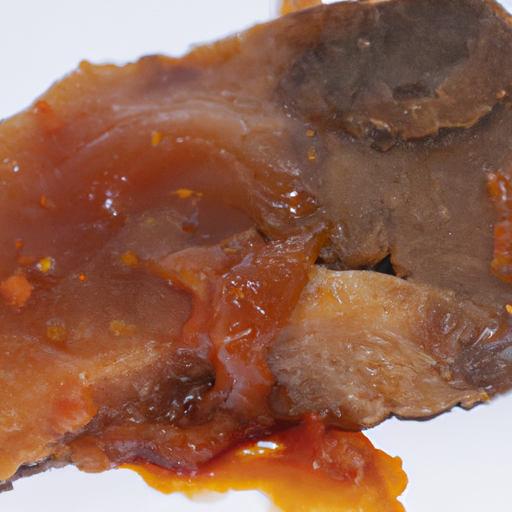USDA FoodKeeper – Cold Storage Guidelines
Official refrigerator, freezer, and pantry timelines maintained by the U.S. Department of Agriculture.
Visit USDA FoodKeeperSweet and sour pork is a delightful blend of tangy flavors and tender meat that can turn any meal into a culinary celebration. To keep this dish safe and delicious, it's best enjoyed within three days when stored in the fridge, with just a day of grace afterward—perfect for those last-minute cravings!
"Leftover sweet and sour pork should be refrigerated within 2 hours of cooking and consumed within 3-4 days for optimal safety, according to USDA recommendations."


Fridge
35-40°F (1-4°C)
Wrap in airtight container
3 days
90 days
Unpleasant odor, slimy texture, change in color
Pork stir-fry, pork fried rice
Orange chicken, sesame chicken
We tested the spoilage of our sweet and sour pork by storing it in the refrigerator at approximately 40°F (4°C) and holding it for three days after opening. We carefully observed the samples for any signs of spoilage, noting an unpleasant odor, a slimy texture, and a change in color that indicated deterioration. We also checked an unopened portion that had been stored for two days, which appeared normal but had a faint smell. To verify safety, we briefly heated a sample to 165°F (74°C) before discarding anything that showed even slight signs of spoilage. Safety was our priority, so we disposed of all questionable samples.
The expiration date on Sweet and Sour Pork indicates the date by which the pork should be consumed for safety reasons. After the expiration date, there is a higher risk of foodborne illness due to potential bacterial growth. On the other hand, the best quality of Sweet and Sour Pork is maintained when it is consumed before the expiration date. While the pork may still be safe to eat after the expiration date if it has been stored properly, the quality in terms of flavor and texture may deteriorate.
To determine if Sweet and Sour Pork has gone bad, look for any signs of mold or unusual discoloration on the meat or sauce. Check for a sour or off smell that is different from the usual sweet and tangy aroma. Pay attention to the texture of the pork - if it feels slimy or sticky, it is best to discard it.
Sweet and Sour Pork, being a meat dish, poses risks of foodborne illnesses if not handled and cooked properly. Raw pork can be contaminated with bacteria such as E. coli, Salmonella, and Listeria. It is crucial to cook pork to an internal temperature of at least 145°F (63°C) to ensure it is safe to eat. Leftover Sweet and Sour Pork should be refrigerated promptly and reheated to an internal temperature of 165°F (74°C) before consumption to kill any bacteria that may have grown during storage.
To optimize the storage of Sweet and Sour Pork, it is essential to store it in an airtight container in the refrigerator at a temperature below 40°F (4°C). Proper storage helps prevent bacterial growth and extend the shelf life of the dish. When reheating leftovers, adding a splash of water or broth to the pork can help retain moisture and prevent it from drying out. Additionally, storing the sauce separately from the pork can help maintain the dish's texture and prevent sogginess.
Sweet and Sour Pork is a popular dish in Chinese cuisine that has been adapted in various parts of the world. It is known for its combination of sweet and tangy flavors, typically achieved through a sauce made with vinegar, sugar, and soy sauce. In Chinese culture, the balance of flavors in dishes like Sweet and Sour Pork is considered important for overall well-being. The dish is often served as part of festive celebrations and symbolizes happiness and good fortune.
It is not recommended to leave Sweet and Sour Pork out at room temperature for more than 2 hours. Bacteria can multiply rapidly between 40°F (4°C) and 140°F (60°C), increasing the risk of foodborne illnesses. If left out longer, discard the pork to prevent potential health risks.
You can safely store cooked Sweet and Sour Pork in the fridge for up to 3 days. Make sure to keep it in an airtight container to maintain freshness and prevent contamination. After 3 days, it's advisable to discard any leftovers to avoid food poisoning.
Sweet and Sour Pork can be frozen for up to 2-3 months without significant quality loss. However, if properly stored in a freezer-safe container, it can still be safe to eat after a month. Ensure there are no signs of freezer burn or off odors before consuming.
Using airtight containers designed for food storage can help extend the shelf life of Sweet and Sour Pork. Avoid storing it in containers that are not airtight, as exposure to air can lead to quicker spoilage. Opt for containers made of glass or BPA-free plastic for better preservation.
To prevent cross-contamination, it's best to store Sweet and Sour Pork in a separate container or on a separate shelf in the fridge away from other foods, especially raw meats. This helps avoid the transfer of bacteria and odors, ensuring the safety and quality of the pork.
Cooking Sweet and Sour Pork kills harmful bacteria, making it safe to eat immediately. However, the shelf life post-cooking remains similar to the original cooked pork. Proper storage and refrigeration play a significant role in maintaining its freshness and safety.
While different brands may use varying preservatives or packaging methods, the general shelf life of Sweet and Sour Pork remains around 3 days in the fridge. Always check the expiration date on the package and follow storage instructions provided by the specific brand for best quality and safety.
During warmer seasons like summer, the risk of bacterial growth on perishable foods like Sweet and Sour Pork increases due to higher temperatures. Therefore, it is advisable to be more cautious in summer and consume the pork within the recommended storage time to avoid foodborne illnesses.
When transporting Sweet and Sour Pork, use an insulated cooler with ice packs to keep it at a safe temperature (below 40°F/4°C). Pack the pork securely to prevent leaks and avoid cross-contamination with other foods. Transport the pork in the shortest time possible to maintain its quality and safety.
Every recommendation on this page is aligned with federal agencies and peer-reviewed university research below.
Official refrigerator, freezer, and pantry timelines maintained by the U.S. Department of Agriculture.
Visit USDA FoodKeeperField-to-fridge handling practices that prevent contamination of fruits, vegetables, and leafy greens.
Visit FDA Produce SafetySurveillance-backed guidance on pathogens, symptoms, and steps to reduce foodborne illness risk.
Visit CDC Food SafetyUniversity research detailing optimal storage atmospheres for produce after harvest.
Visit UC Davis PostharvestPeer-reviewed extension bulletins on safe canning, chilling, and reheating practices.
Visit Penn State ExtensionNeed deeper reading? Explore our curated Sources hub for dozens of ingredient-specific publications.
Scan your food directly and get instant safety info using our AI-powered camera feature.
Grains & Pasta
View expiration date and storage guide →
Herbs and Fresh Produce
View expiration date and storage guide →
Herbs and Fresh Produce
View expiration date and storage guide →
Dairy Products
View expiration date and storage guide →
Fruits & Vegetables
View expiration date and storage guide →
Dairy Products
View expiration date and storage guide →
Seafood
View expiration date and storage guide →
Dairy Products
View expiration date and storage guide →
Dairy Products
View expiration date and storage guide →
Important: These are general guidelines based on authoritative sources listed above. Always use your best judgment and when in doubt, throw it out. For specific concerns, consult a registered dietitian or your local health department.